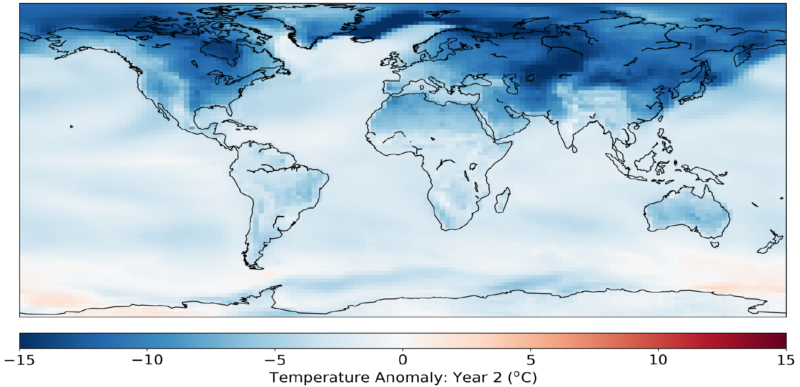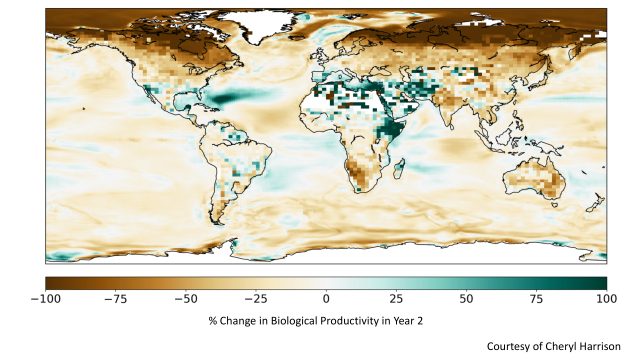Darker Timelines –
50 – (million immediate deaths, and then the weather changes.)

Enlarge/Simulated temperature changes 2 years after a hypothetical nuclear war between India and Pakistan.
There are few things humans have committed to as whole-heartedly as the art of killing. The culmination of this effort (so far) are nuclear bombs. Not only do these weapons have an almost impossible ability to take lives around the targeted location, but scientists have also warned that nuclear wars would have drastic climate impacts around the world.
While that general idea is pretty well known, shifting tensions and growing nuclear arsenals have provided a number of different scenarios to analyze over the years. The latest study, led byOwen Toon(a student of Carl Sagan), simulates a plausible war between India and Pakistan in which the combatants use the nuclear weapons they’re likely to possess by 2025.
Escalation
While small wars have broken out between these countries periodically, each has stockpiled nuclear weapons in the hope of creating a threat too terrible to risk further conflict. India has a stated no-first-use policy (unless it’s attacked by chemical or biological weapons), while Pakistan’s policy is that it won’t strike first … unless it sees nukes as the only way to halt an invasion. Details on the precise number of weapons each country has, as well as the yield of those weapons, are hard to come by. But there’s certainly a lot of firepower.
Toon and his team of researchers rely on huge amounts of previous research to construct a plausible scenario for a nuclear exchange. The conflagration might start with a terrorist attack on the Indian government, they say, leading to Indian forces entering Pakistan. Pakistan responds with the use of a handful of tactical nuclear weapons targeting those tanks and troops. India responds with nukes targeting Pakistani military installations, including sites where they believe Pakistan stores nuclear weapons.
From there, everything spirals out of control. Before the end, 100 Indian nukes hit cities in Pakistan, while 150 Pakistani airburst attacks hit cities in India. (This is partly based on the belief that India would reserve many of its nuclear weapons to deter China from joining in the war.)
Depending on the actual yield of these weapons, this would be the deaths of 50 to 125 million people — equivalent to the death toll of World War II at a minimum, but inside a week.
Globalization
The catastrophe would not be restricted by national borders. Nuclear explosions burn sizable areas around the target, with heat so intense that near-complete incineration is possible. The soot particles generated by these fires would be lifted into the upper troposphere. Some of that would fall to the ground with rain, but much of it would absorb sunlight, heating the surround air and riding the resultant rising motion into the stratosphere. Once in the stratosphere, it can stay suspended much longer and encircle the planet. (This is also how some volcanic eruptions produce a global climate impact.)
With estimates of fire extent and the amount of combustible material in those areas, the researchers ran climate-model simulations of what the soot – 16 to 36 million metric tons of it— would do in the atmosphere. They actually used the same model that recentlyproduced a simulationof the Chicxulub impact at the end-Cretaceous mass extinction.
Simply put, soot would block about 20% to 30% of the Sun’s light, globally. That’s a decrease of about (W to) W per square meter of the Earth’s surface. For comparison, the 1991 eruption of Mount Pinatubo caused a decrease of 4W per square meter. The result would be a 2 ° C to 5 ° C (about 4 ° F to 9 ° F) global cooling. Temperatures would reach their lowest after about three years and maintain that level for another four years. Getting back to previous temperatures would take over a decade.
The cooling would slow the hydrologic cycle and decrease rainfall by 15% to 30% percent globally, with impacts varying in different regions. In India and central China, for example, precipitation would drop to nearly zero. The Northeastern and Midwestern United States would see a decline of 50%.
The temperature, precipitation, and sunlight change would obviously impact photosynthesis on land and in the ocean. The model estimated a 15% to 30 % drop in growth on land — known as Net Primary Productivity — and a 5% to 15% drop in the ocean.

(Enlarge)/Simulated drop in plant growth due to sunlight, temperature, and precipitation changes.
Cheryl S. Harrison, Lili Xi, and Nicole Lovenduski
“Should a war between India and Pakistan ever occur, as assumed here,” the researchers write, “these countries alone could suffer 50 to 125 million fatalities, a regional catastrophe. In addition, severe short-term climate perturbations, with temperatures declining to values not seen on Earth since the middle of the last Ice Age, would b e triggered by smoke from burning cities, a global disaster threatening food production worldwide and mass starvation, as well as severe disruption to natural ecosystems. “
Science Advances, 2019. DOI:10. 1126 / sciadv.aay 5478(About DOIs).







GIPHY App Key not set. Please check settings